Dynamic Mechanical and Microstructural Properties of Outburst-Prone Coal Based on Compressive SHPB Tests
Abstract
1. Introduction
2. Laboratory Specimen and Test Setup
2.1. Specimen Procurement and Preparation
2.2. Apparatus and Basic Principles for SHPB Tests
2.3. Methodology and Apparatus of SEM and NMR Tests
3. Results and Discussion
3.1. Effect of Strain Rate on Dynamic Mechanical Properties
3.2. Effect of Strain Rate on Fragment Size Distribution
3.3. Effect of Strain Rate on Microstructural Characteristics
4. Conclusions
- (1)
- The dynamic stress-strain response of specimens primarily comprised stages of compression, linear elastic deformation then, micro-crack evolution, followed by unstable crack propagation, culminating in rapid unloading. The compressive strength inclined linearly with the applied strain rate.
- (2)
- When the impact loading rate was relatively low, only the micro-cracks consuming reduced energy adsorption participated in rupturing the coal specimen, and fragments failed in tension as apparent in the development of a typical tensile failure surface. With the impact’s stress increasing, the fragments failed predominantly in shear. The equivalent particle size of the coal fragments decreased with the applied strain rate. The equivalent particle size of outburst-prone coal was smaller than that of outburst-resistant coal.
- (3)
- Observed by the SEM and NMR, the microstructure changed dramatically with the strain rates. When the impact load was low, the pores and fractures were mainly isolated, and the connectivity between them was poor. As the impact load increased, the primary fractures expanded and propagated through the isolated pores, causing numerous pores to break to form secondary fractures.
- (4)
- With the increase of strain rate, the proportion of fractures in coal tended to increase, the ratio of pore throat with diameter <0.1 μm decreased, and the ratio of pore throat with diameter >10 μm firstly decreased slightly and then increased rapidly.
Author Contributions
Funding
Acknowledgments
Conflicts of Interest
References
- Beamish, B.B.; Crosdale, P.J. Instantaneous outbursts in underground coal mines: An overview and association with coal type. Int. J. Coal Geol. 1998, 35, 27–55. [Google Scholar] [CrossRef]
- Xu, T.; Tang, C.A.; Yang, T.H.; Zhu, W.C.; Liu, J. Numerical investigation of coal and gas outbursts in underground collieries. Int. J. Rock Mech. Min. Sci. 2006, 43, 905–919. [Google Scholar] [CrossRef]
- Liu, T.; Lin, B.; Yang, W.; Zou, Q.; Jia, K.; Yan, F. Cracking process and stress field evolution in specimen containing combined flaw under uniaxial compression. Rock Mech. Rock Eng. 2016, 49, 3095–3113. [Google Scholar] [CrossRef]
- Lama, R.D.; Bodziony, J. Management of outburst in underground coal mines. Int. J. Coal Geol. 1998, 35, 83–115. [Google Scholar] [CrossRef]
- Wang, G.; Gong, S.; Dou, L.; Cai, W.; Jin, F.; Fan, C. Behaviour and bursting failure of roadways based on a pendulum impact test facility. Tunn. Undergr. Space Technol. 2019, 92, 103042. [Google Scholar] [CrossRef]
- Wang, G.; Gong, S.; Dou, L.; Cai, W.; Yuan, X.; Fan, C. Rockburst mechanism and control in coal seam with both syncline and hard strata. Saf. Sci. 2019, 115, 320–328. [Google Scholar] [CrossRef]
- Wang, G.; Jin, F.; Gong, S.; Dou, L.; Fan, C.; Cai, W.; Yuan, X. Generating behaviors of strong tremors and experimental study of rockburst-triggering criterion. Shock Vib. 2019, 2019, 6319612. [Google Scholar] [CrossRef]
- Fan, C.; Li, S.; Luo, M.; Yang, Z.; Lan, T. Numerical simulation of hydraulic fracturing in coal seam for enhancing underground gas drainage. Energ. Explor. Exploit. 2019, 37, 166–193. [Google Scholar] [CrossRef]
- Fan, C.; Li, S.; Luo, M.; Du, W.; Yang, Z. Coal and gas outburst dynamic system. Int. J. Min. Sci. Technol. 2017, 27, 49–55. [Google Scholar] [CrossRef]
- Zhao, W.; Cheng, Y.; Guo, P.; Jin, K.; Tu, Q.; Wang, H. An analysis of the gas-solid plug flow formation: New insights into the coal failure process during coal and gas outbursts. Powder Technol. 2017, 305, 39–47. [Google Scholar] [CrossRef]
- Yin, G.; Jiang, C.; Wang, J.G.; Xu, J.; Zhang, D.; Huang, G. A new experimental apparatus for coal and gas outburst simulation. Rock Mech. Rock Eng. 2016, 49, 2005–2013. [Google Scholar] [CrossRef]
- Zhao, W.; Cheng, Y.; Jiang, H.; Jin, K.; Wang, H.; Wang, L. Role of the rapid gas desorption of coal powders in the development stage of outbursts. J. Nat. Gas Sci. Eng. 2016, 28, 491–501. [Google Scholar] [CrossRef]
- Xue, Y.; Gao, F.; Liu, X. Effect of damage evolution of coal on permeability variation and analysis of gas outburst hazard with coal mining. Nat. Hazards 2015, 79, 999–1013. [Google Scholar] [CrossRef]
- Fan, C.; Elsworth, D.; Li, S.; Zhou, L.; Yang, Z.; Song, Y. Thermo-hydro-mechanical-chemical couplings controlling CH4 production and CO2 sequestration in enhanced coalbed methane recovery. Energy 2019, 173, 1054–1077. [Google Scholar] [CrossRef]
- Liu, H.; Lin, B.; Mou, J.; Yang, W. Mechanical evolution mechanism of coal and gas outburst. Rock Mech. Rock Eng. 2019, 52, 1591–1597. [Google Scholar] [CrossRef]
- An, F.; Yuan, Y.; Chen, X.; Li, Z.; Li, L. Expansion energy of coal gas for the initiation of coal and gas outbursts. Fuel 2019, 235, 551–557. [Google Scholar] [CrossRef]
- Han, J.; Zhang, H. The controlling of tectonic evolution to coal and gas outburst. J. China Coal Soc. 2010, 35, 1125–1130. [Google Scholar]
- Wang, G.; Qin, X.; Shen, J.; Zhang, Z.; Han, D.; Jiang, C. Quantitative analysis of microscopic structure and gas seepage characteristics of low-rank coal based on CT three-dimensional reconstruction of CT images and fractal theory. Fuel 2019, 256, 115900. [Google Scholar] [CrossRef]
- Wang, G.; Jiang, C.; Shen, J.; Han, D.; Qin, X. Deformation and water transport behaviors study of heterogenous coal using CT-based 3D simulation. Int. J. Coal Geol. 2019, 211, 103204. [Google Scholar] [CrossRef]
- Li, H.; Shi, S.; Lu, J.; Ye, Q.; Lu, Y.; Zhu, X. Pore structure and multifractal analysis of coal subjected to microwave heating. Powder Technol. 2019, 346, 97–108. [Google Scholar] [CrossRef]
- Li, H.; Shi, S.; Lin, B.; Lu, J.; Lu, Y.; Ye, Q.; Wang, Z.; Hong, Y.; Zhu, X. A fully coupled electromagnetic, heat transfer and multiphase porous media model for microwave heating of coal. Fuel Process. Technol. 2019, 189, 49–61. [Google Scholar] [CrossRef]
- Huang, Q.; Liu, S.; Wang, G.; Wu, B.; Yang, Y.; Liu, Y. Gas sorption and diffusion damages by guar-based fracturing fluid for CBM reservoirs. Fuel 2019, 251, 30–44. [Google Scholar] [CrossRef]
- Song, Y.; Jiang, B.; Lan, F. Competitive adsorption of CO2/N2/CH4 onto coal vitrinite macromolecular: Effects of electrostatic interactions and oxygen functionalities. Fuel 2019, 235, 23–38. [Google Scholar]
- Fan, C.; Elsworth, D.; Li, S.; Chen, Z.; Luo, M.; Song, Y.; Zhang, H. Modelling and optimization of enhanced coalbed methane recovery using CO2/N2 mixtures. Fuel 2019, 253, 1114–1129. [Google Scholar] [CrossRef]
- Norbert, S.; Pajdak, A.; Kozieł, K.; Braga, L.T.P. Methane emission during gas and rock outburst on the basis of the unipore model. Energies 2019, 12, 1999. [Google Scholar] [CrossRef]
- Skoczylas, N. Coal Seam Methane Pressure as a Parameter Determining the Level of the Outburst Risk–Laboratory and in Situ Research. Arch. Min. Sci. 2012, 57, 861–869. [Google Scholar]
- Song, H.; Jiang, Y.; Elsworth, D.; Zhao, Y.; Wang, J.; Liu, B. Scale effects and strength anisotropy in coal. Int. J. Coal Geol. 2018, 195, 37–46. [Google Scholar] [CrossRef]
- Singh, J.G. A mechanism of outbursts of coal and gas. Min. Sci. Technol. 1984, 1, 269–273. [Google Scholar] [CrossRef]
- Li, H.; Shi, S.; Lin, B.; Lu, J.; Ye, Q.; Lu, Y.; Zhu, X. Effects of microwave-assisted pyrolysis on the microstructure of bituminous coals. Energy 2019, 187, 115986. [Google Scholar] [CrossRef]
- Barker-read, G.R.; Radchenko, S.A. The relationship between the pore structure of coal and gas-dynamic behaviour of coal seams. Min. Sci. Technol. 1989, 8, 109–131. [Google Scholar] [CrossRef]
- Xia, K.; Huang, S.; Jha, A.K. Dynamic tensile test of coal, shale and sandstone using split Hopkinson pressure bar: A tool for blast and impact assessment. Int. J. Geotech. Earthq. Eng. 2010, 1, 24–37. [Google Scholar] [CrossRef]
- Feng, J.; Wang, E.; Chen, X.; Ding, H. Energy dissipation rate: An indicator of coal deformation and failure under static and dynamic compressive loads. Int. J. Min. Sci. Technol. 2018, 28, 397–406. [Google Scholar] [CrossRef]
- Fakhimi, A.; Azhdari, P.; Kimberley, J. Physical and numerical evaluation of rock strength in Split Hopkinson Pressure Bar testing. Comput. Geotech. 2018, 102, 1–11. [Google Scholar] [CrossRef]
- Ju, Y.; Sudak, L.; Xie, H. Study on stress wave propagation in fractured rocks with fractal joint surfaces. Int. J. Solids Struct. 2007, 44, 4256–4271. [Google Scholar] [CrossRef]
- Feng, J.; Wang, E.; Chen, L.; Li, X.; Xu, Z.; Li, G. Experimental study of the stress effect on attenuation of normally incident P-wave through coal. J. Appl. Geophys. 2016, 132, 25–32. [Google Scholar] [CrossRef]
- Zhou, Z.; Cai, X.; Ma, D.; Du, X.; Chen, L.; Wang, H.; Zang, H. Water saturation effects on dynamic fracture behavior of sandstone. Int. J. Rock Mech. Min. 2019, 114, 46–61. [Google Scholar] [CrossRef]
- Zhou, Z.; Cai, X.; Ma, D.; Chen, L.; Wang, S.; Tan, L. Dynamic tensile properties of sandstone subjected to wetting and drying cycles. Constr. Build. Mater. 2018, 182, 215–232. [Google Scholar] [CrossRef]
- Li, M.; Lin, G.; Zhou, W.; Mao, X.; Zhang, L.; Mao, R. Experimental study on dynamic tensile failure of sandstone specimens with different water contents. Shock Vib. 2019, 2019, 7012752. [Google Scholar] [CrossRef]
- Ma, D.; Rezania, M.; Yu, H.; Bai, H. Variations of hydraulic properties of granular sandstones during water inrush: Effect of small particle migration. Eng. Geol. 2017, 217, 61–70. [Google Scholar] [CrossRef]
- Liu, M.; He, X. Electromagnetic response of outburst-prone coal. Int. J. Coal Geol. 2001, 45, 155–162. [Google Scholar]
- Jiang, C.; Xu, L.; Li, X.; Tang, J.; Chen, Y.; Tian, S.; Liu, H. Identification model and indicator of outburst-prone coal seams. Rock Mech. Rock Eng. 2015, 48, 409–415. [Google Scholar] [CrossRef]
- Qi, L.; Tang, X.; Wang, Z.; Peng, X. Pore characterization of different types of coal from coal and gas outburst disaster sites using low temperature nitrogen adsorption approach. Int. J. Min. Sci. Technol. 2017, 27, 371–377. [Google Scholar] [CrossRef]
- Zhao, Y.; Gong, S.; Hao, X.; Peng, Y.; Jiang, Y. Effects of loading rate and bedding on the dynamic fracture toughness of coal: Laboratory experiments. Eng. Fract. Mech. 2017, 178, 375–391. [Google Scholar] [CrossRef]
- Xia, K.; Yao, W. Dynamic rock tests using split Hopkinson (Kolsky) bar system—A review. J. Rock. Mech. Geotech. Eng. 2015, 7, 27–59. [Google Scholar] [CrossRef]
- Li, M.; Mao, X.; Lu, A.; Tao, J.; Zhang, G.; Zhang, L.; Li, C. Effect of specimen size on energy dissipation characteristics of red sandstone under high strain rate. Int. J. Min. Sci. Technol. 2014, 24, 151–156. [Google Scholar] [CrossRef]
- Wang, W.; Wang, H.; Li, D.; Li, H.; Liu, Z. Strength and failure characteristics of natural and water-saturated coal specimens under static and dynamic loads. Shock Vib. 2018, 2018, 3526121. [Google Scholar] [CrossRef]
- Luo, X.; Xu, J.Y.; Bai, E.L.; Li, W. Research on the dynamic compressive test of highly fluidized geopolymer concrete. Constr. Build. Mater. 2013, 48, 166–172. [Google Scholar] [CrossRef]
- Frew, D.J.; Forrestal, M.J.; Chen, W. Pulse shaping techniques for testing brittle materials with a split Hopkinson pressure bar. Exp. Mech. 2002, 42, 93–106. [Google Scholar] [CrossRef]
- Li, M.; Mao, X.; Cao, L.; Pu, H.; Mao, R.; Lu, A. Effects of thermal treatment on the dynamic mechanical properties of coal measures sandstone. Rock Mech. Rock Eng. 2016, 49, 3525–3539. [Google Scholar] [CrossRef]
- Huo, B.; Jing, X.; Fan, C.; Han, Y. Numerical investigation of flue gas injection enhanced underground coal seam gas drainage. Energy Sci. Eng. 2019. [Google Scholar] [CrossRef]
- Li, C.; Wei, S.; Wang, X.; Liu, J.; Lei, D. Experiment of dynamic property and transient magnetic effects of coal during deformation and fracture. J. Coal Sci. Eng. 2012, 18, 258–261. [Google Scholar] [CrossRef]
- Zhao, Y.; Gong, S.; Zhang, C.; Zhang, Z.; Jiang, Y. Fractal characteristics of crack propagation in coal under impact loading. Fractals 2018, 26, 1840014. [Google Scholar] [CrossRef]
- Li, C.; Wang, Q.; Lyu, P. Study on electromagnetic radiation and mechanical characteristics of coal during an SHPB test. J. Geophys. Eng. 2016, 13, 391–398. [Google Scholar]
- ISRM. The complete ISRM suggested methods for rock characterization, testing and monitoring: 1974–2006. Int. Soc. Rock Mech. Comm. Test Methods 2007, 15, 47–48. [Google Scholar]
- Yao, Y.; Liu, D.; Cai, Y.; Li, J. Advanced characterization of pores and fractures in coals by nuclear magnetic resonance and X-ray computed tomography. Sci. China Earth Sci. 2010, 53, 854–862. [Google Scholar] [CrossRef]
- Yao, Y.; Liu, D.; Che, Y.; Tang, D.; Tang, S.; Huang, W. Petrophysical characterization of coals by low-field nuclear magnetic resonance (NMR). Fuel 2010, 89, 1371–1380. [Google Scholar] [CrossRef]
- Cai, Y.; Liu, D.; Pan, Z.; Yao, Y.; Li, J.; Qiu, Y. Pore structure and its impact on CH4 adsorption capacity and flow capability of bituminous and subbituminous coals from Northeast China. Fuel 2013, 103, 258–268. [Google Scholar] [CrossRef]
- Sing, K.S.W. Reporting physisorption data for gas/solid systems with special reference to the determination of surface area and porosity (Recommendations 1984). Pure Appl. Chem. 1985, 57, 603–619. [Google Scholar] [CrossRef]
- Yu, S.; Bo, J.; Pei, S.; Jiahao, W. Matrix compression and multifractal characterization for tectonically deformed coals by Hg porosimetry. Fuel 2018, 211, 661–675. [Google Scholar] [CrossRef]
- Yu, S.; Bo, J.; Jie-gang, L. Nanopore structural characteristics and their impact on methane adsorption and diffusion in low to medium tectonically deformed coals: Case study in the Huaibei coal field. Energy Fuel 2017, 31, 6711–6723. [Google Scholar] [CrossRef]
- Wang, L.; Chen, Z.; Wang, C.; Elsworth, D.; Liu, W. Reassessment of coal permeability evolution using steady-state flow methods: The role of flow regime transition. Int. J. Coal Geol. 2019, 211, 103210. [Google Scholar] [CrossRef]
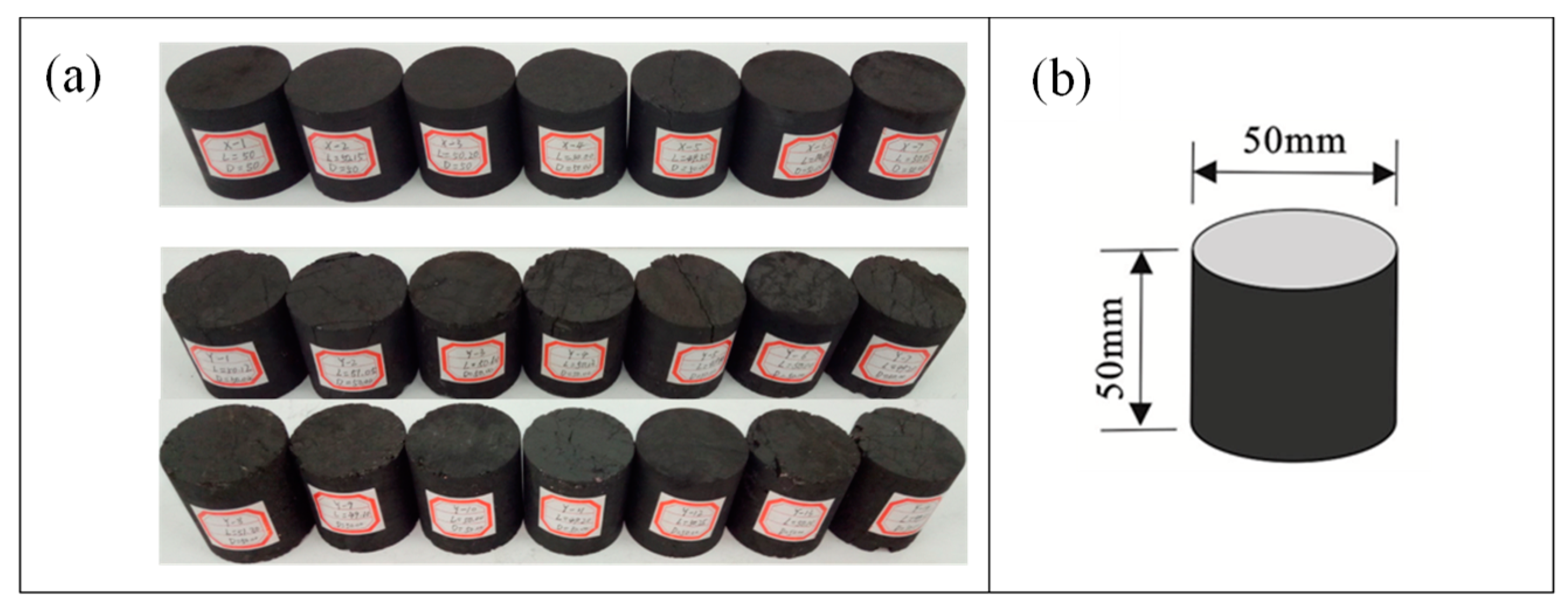


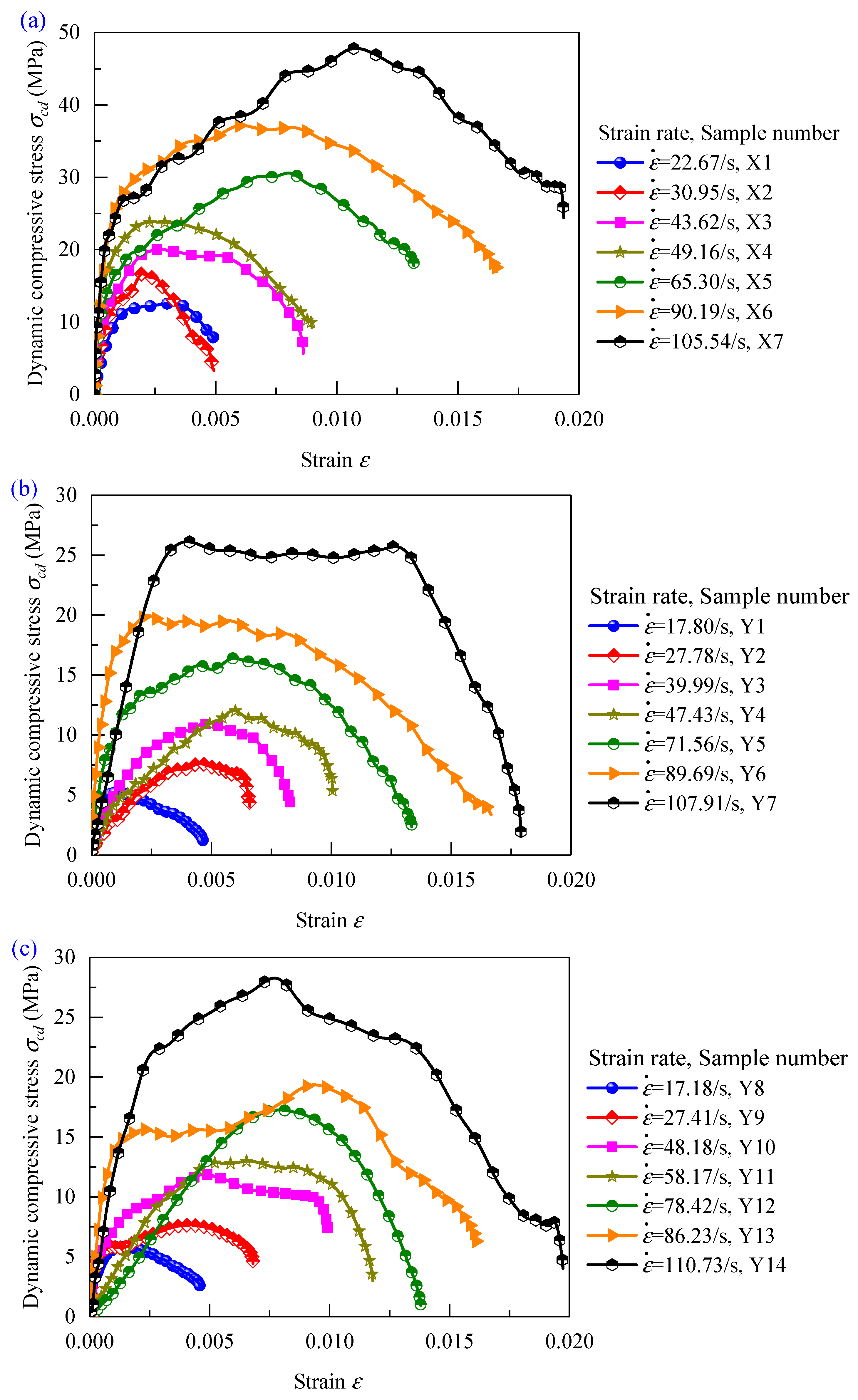
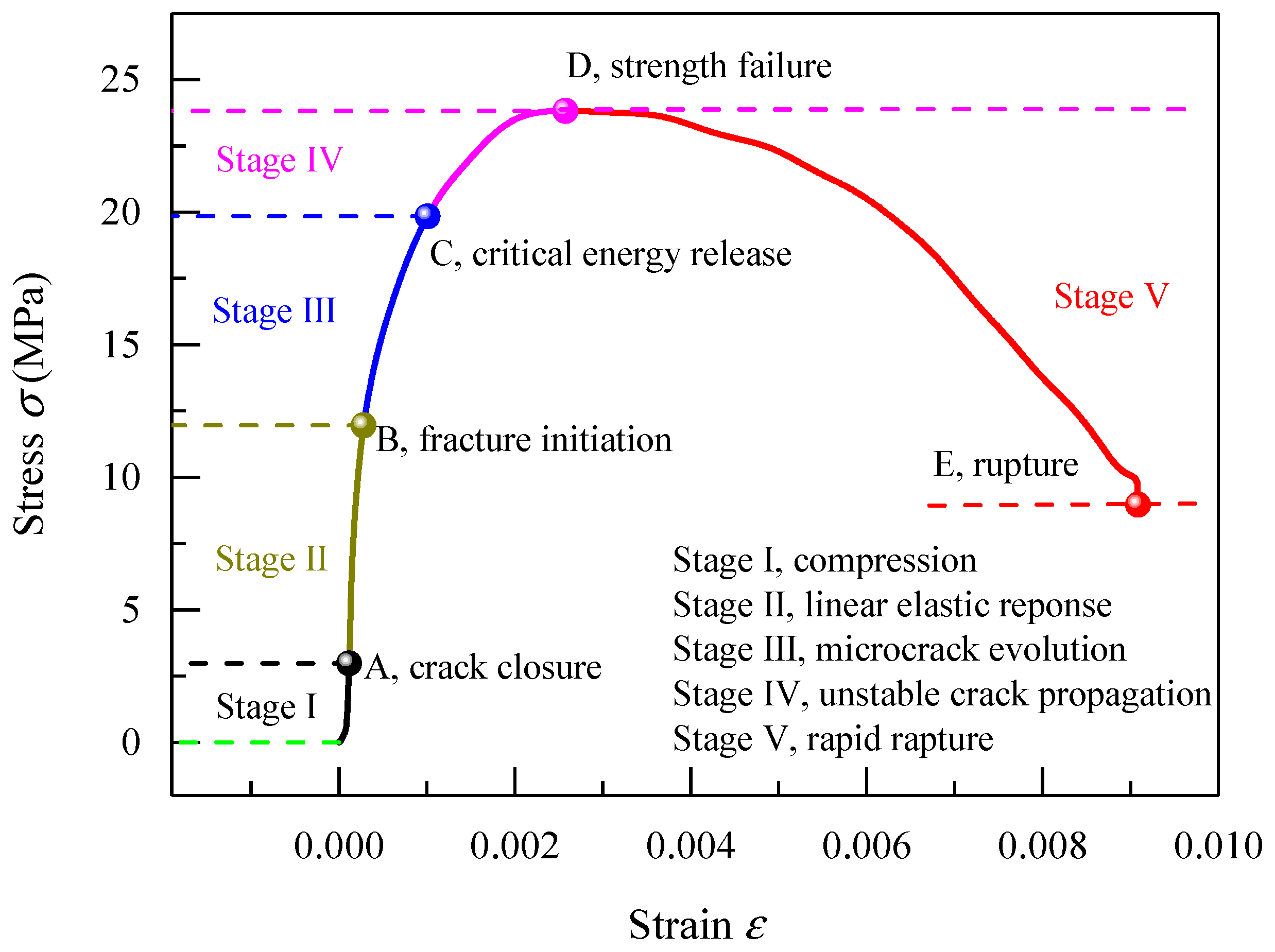
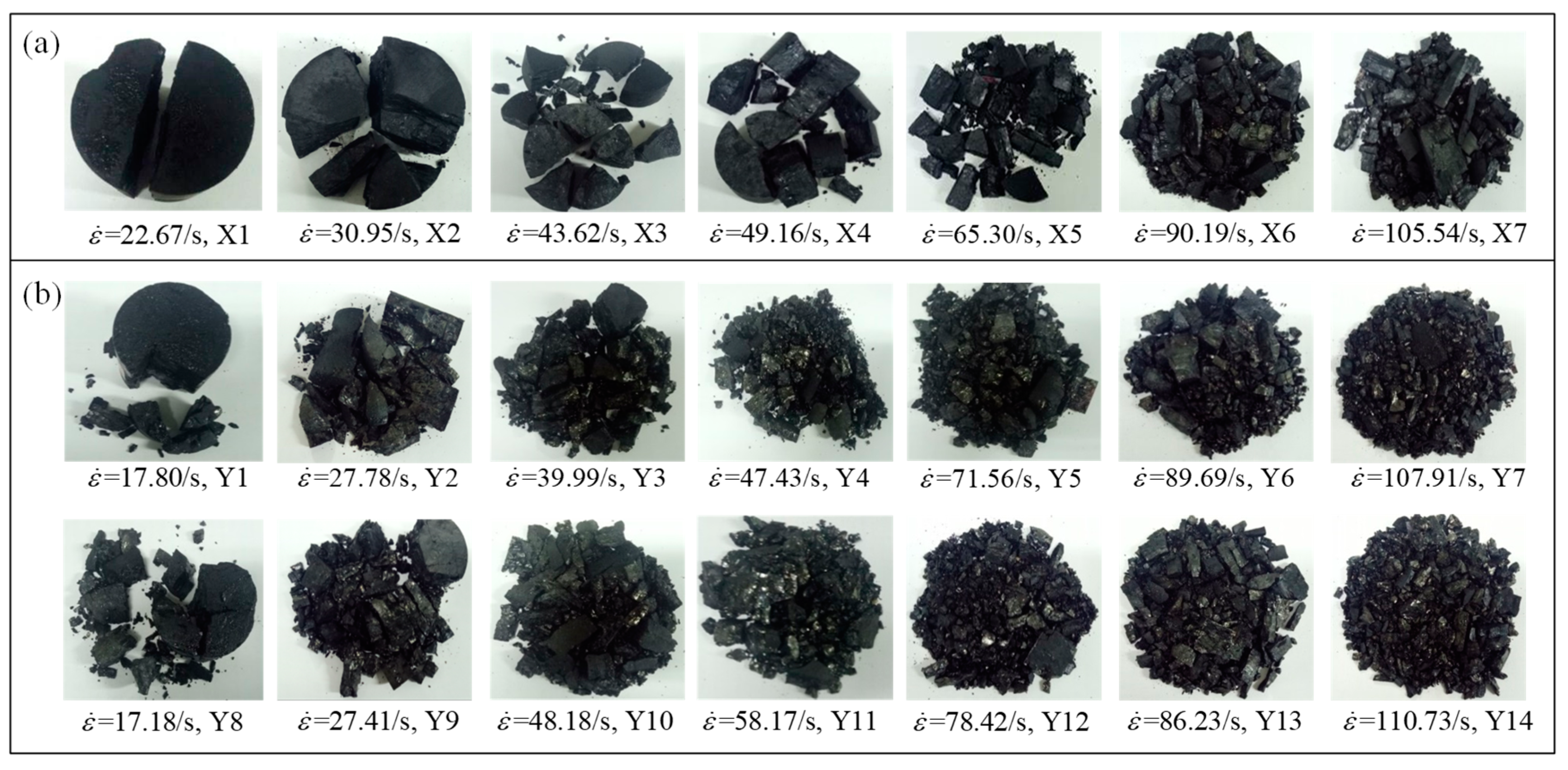
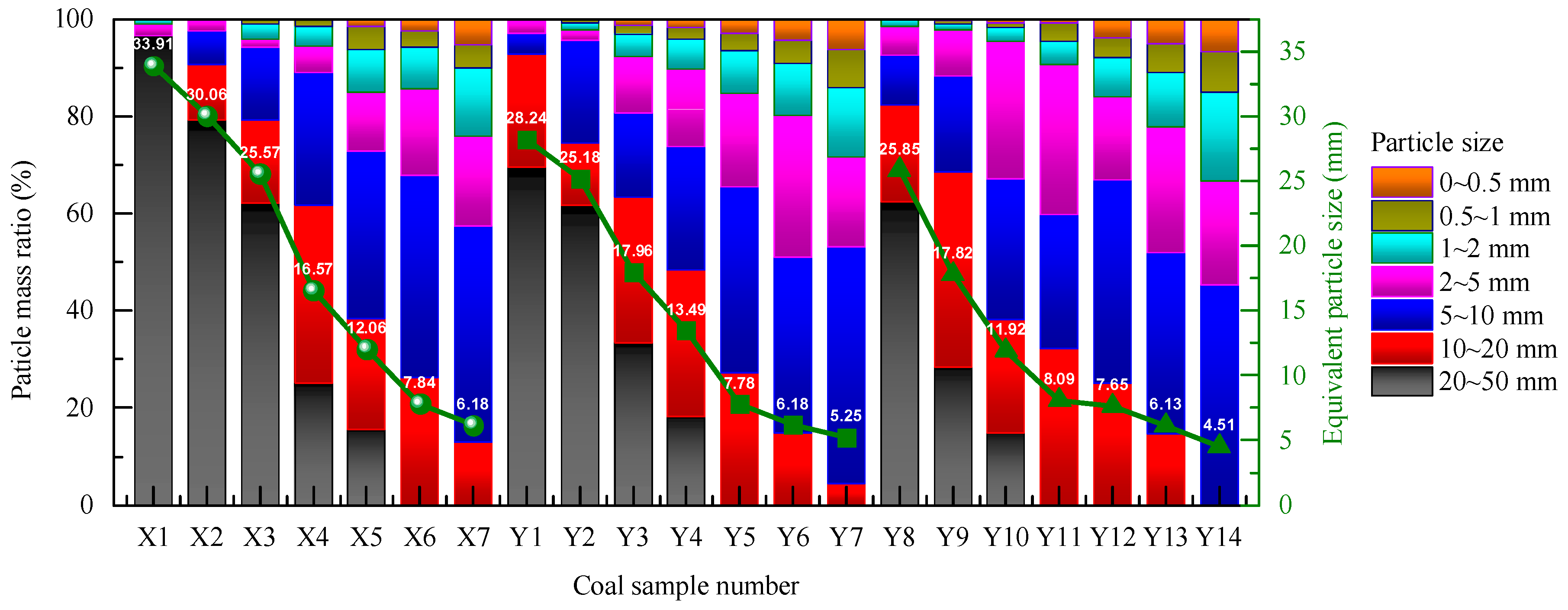

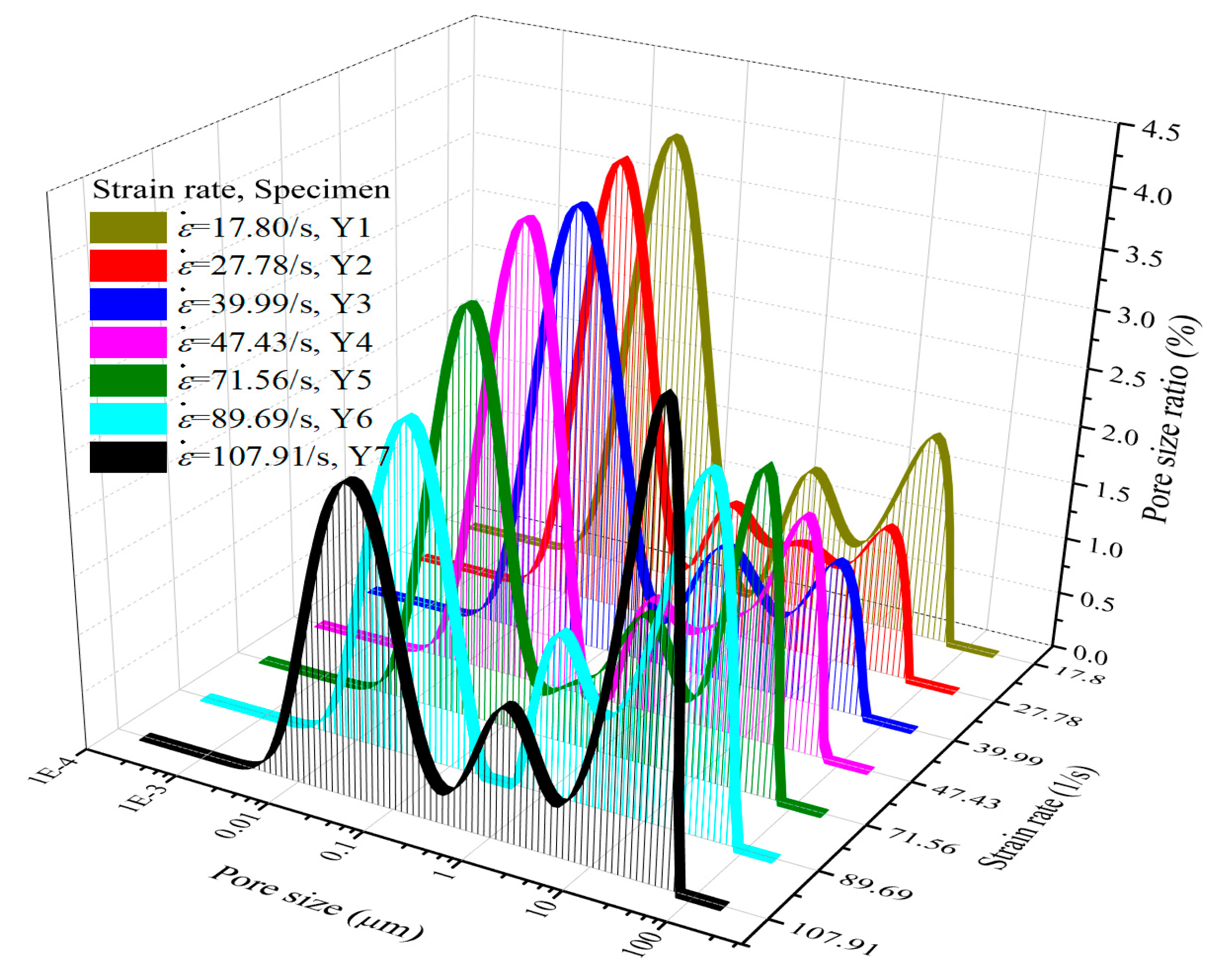

| Specimen | Dry Density, ρd (g/cm3) | Uniaxial Compressive Strength, σc (MPa) | Tensile Strength, σt (MPa) | Elastic Modulus, Et (GPa) | Poisson Ratio, ν |
|---|---|---|---|---|---|
| Xintian coal (prone) | 1.36 | 4.76 | 0.68 | 2.34 | 0.28 |
| Xinzhouyao coal (resistant) | 1.29 | 11.45 | 1.45 | 3.98 | 0.24 |
| Specimen Number | Average Strain Rate (1/s) | <0.1 μm Throat Ratio (%) | >10 μm Throat Ratio (%) |
|---|---|---|---|
| Y1 | 17.80 | 58.14 | 16.35 |
| Y2 | 27.78 | 55.45 | 13.44 |
| Y3 | 39.99 | 54.54 | 12.94 |
| Y4 | 47.43 | 54.53 | 20.58 |
| Y5 | 71.56 | 46.84 | 25.18 |
| Y6 | 89.69 | 40.75 | 33.11 |
| Y7 | 107.91 | 38.85 | 36.01 |
© 2019 by the authors. Licensee MDPI, Basel, Switzerland. This article is an open access article distributed under the terms and conditions of the Creative Commons Attribution (CC BY) license (http://creativecommons.org/licenses/by/4.0/).
Share and Cite
Yang, Z.; Fan, C.; Lan, T.; Li, S.; Wang, G.; Luo, M.; Zhang, H. Dynamic Mechanical and Microstructural Properties of Outburst-Prone Coal Based on Compressive SHPB Tests. Energies 2019, 12, 4236. https://doi.org/10.3390/en12224236
Yang Z, Fan C, Lan T, Li S, Wang G, Luo M, Zhang H. Dynamic Mechanical and Microstructural Properties of Outburst-Prone Coal Based on Compressive SHPB Tests. Energies. 2019; 12(22):4236. https://doi.org/10.3390/en12224236
Chicago/Turabian StyleYang, Zhenhua, Chaojun Fan, Tianwei Lan, Sheng Li, Guifeng Wang, Mingkun Luo, and Hongwei Zhang. 2019. "Dynamic Mechanical and Microstructural Properties of Outburst-Prone Coal Based on Compressive SHPB Tests" Energies 12, no. 22: 4236. https://doi.org/10.3390/en12224236
APA StyleYang, Z., Fan, C., Lan, T., Li, S., Wang, G., Luo, M., & Zhang, H. (2019). Dynamic Mechanical and Microstructural Properties of Outburst-Prone Coal Based on Compressive SHPB Tests. Energies, 12(22), 4236. https://doi.org/10.3390/en12224236




